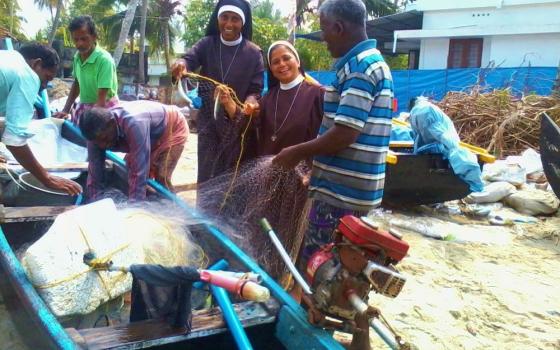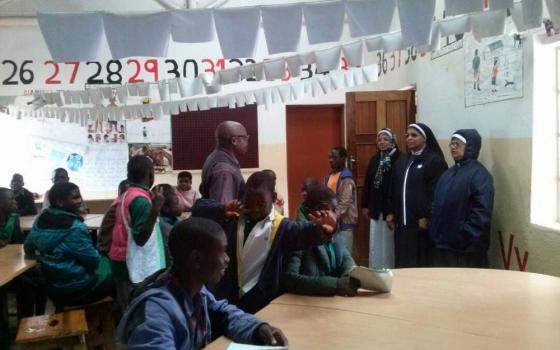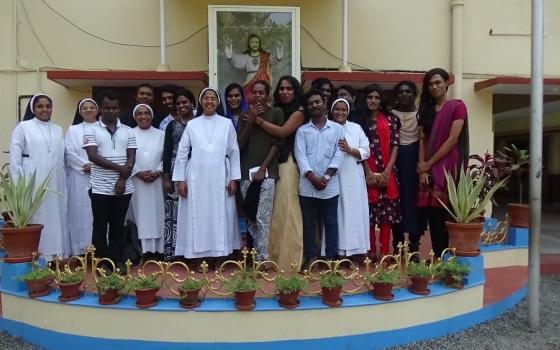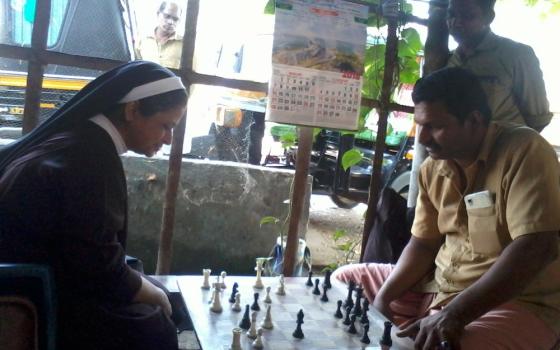Religious life is filled with social revolutionaries — and the Congregation of Mother of Carmel, the first women's religious congregation in India, is no exception. Members embody this spirit of their founder, Carmelites of Mary Immaculate Fr. Kuriakose Elias Chavara, committed to courageous ingenuity to bring about a better world. His most ingenious action was probably founding this congregation in Kerala in 1866.
I met Sister Sibi, superior general of Mother of Carmel, at the UISG (International Union of Superiors General) Constellation meeting in the Philippines last November, where I learned about their history. Sibi's vocation was nurtured by her Catholic family. Her father was a politician and agriculturist, and her mother, still living, cared for the family of eight children. Two sisters and an aunt also belong to the congregation. Sister Sibi, having a doctorate in canon law, taught in seminaries and formation houses for several years before she was elected as superior general in 2015. The Mother of Carmel membership is nearly 7,000 sisters, with an added 300 in various stages of formation. It is not an easy task to lead so many sisters in many parts of the world, so Sibi's responsibilities are shared by six general councilors, 21 provincials, two vice provincials and five regional superiors.
That the congregation was founded in Kerala did not surprise me because nearly every other religious sister or priest I meet outside of India seems to be from that state, the most Catholic in India. I was fascinated to learn that the congregation belongs to the Syro-Malabar rite, originated by St. Thomas the Apostle, in the year 52. This church is in communion with Rome and is the third largest self-governing Catholic Church after the Latin and Byzantine Ukrainian Rites. Liturgies are celebrated according to the Chaldean Catholic Church rituals in Iraq. Church leaders describe it as Catholic by faith, Indian by culture and East Syriac in liturgy.
A Catholic News Agency article about the rites of the Catholic Church explains: "A rite represents an ecclesiastical tradition about how the sacraments are to be celebrated. Different ways evolved as the early church grew and spread to different cultures. Rome, Syria (Antioch) and Egypt (Alexandria) were the major cultural centers of the first centuries. … Each rite has equal dignity, having the same rights and obligations. These different ritual churches are also present in the United States and other countries around the world."
The Congregation of Mother of Carmel was originally cloistered, as enclosure for women religious was common in the 1800s, and isolation and poverty brought many challenges for survival. Fr. Chavara wrote, "The life of sisters in the present structure [convent] was very pitiable. Because it was made of fresh bamboos, bamboo mats that were not yet dry, and unprocessed tender coconut logs, they fall easy victims to moths and termites. Hence there was need to construct a stronger and permanent building." To make a new building, initiatives for building a new convent were taken up, such as families setting apart "a handful of rice" (pidiyari) every day while preparing a meal.
As the group became securely established, other bishops invited the sisters to their dioceses. Each new foundation became independent and evolved somewhat differently, gradually engaging in external apostolic ministries. Unification of these diverse units took place in 1963, and the congregation received pontifical status in 1967. Mother of Carmel sisters follow a Carmelite spirituality, living a semi-contemplative life of silence, solitude, poverty and intimacy with Jesus. They espouse, "Be holy and lead others to holiness," the motto of their founder and co-founders, Chavara and Sr. Euphrasia Eluvathingal (both canonized in 2014) and Fr. Leopold Beccaro. Their primary apostolic mission is education and empowerment of women and children and ministering to their spiritual needs.
• Timeline of Congregation of Mother of Carmel (CMC) community history
The majority of the sisters are Indian and traditionally lived "their life rooted in the Indian culture," the spiritual heritage and traditions of the St. Thomas Christians and the stories and memories of the founders and first members. However, beginning in 1976, the sisters moved out of India to four other continents where local women joined, thus incorporating new cultures into daily community life. Today, learning to live inter-culturally is a new focus in religious life, but not so new for the Indian sisters who had previously joined from very diverse cultures of India. The congregation continues to offer opportunities for learning about and incorporating cultural differences in their life together, including using local languages to impart the congregation's spirituality and charism, particularly during formation periods.
Apostolic commitments worldwide include academic education, healing ministries and social work — and faith formation is central to them all, flowing from the spiritual and apostolic vision of the congregation. Ten percent of each community forms a faith formation team to initiate others into a contemplative perspective of life through prayer and commitment to remedy the problems of our world of turmoil. The teams offer counseling, youth ministry, preaching and retreats. A companion initiative for today's social media focus, sisters are using YouTube and Facebook to preach the word of God.
CMC Sisters manage 740 educational institutions, all rooted in a convent boarding home (not a school) started for girls in 1866. Each institution, whether in city or remote rural area, follows the Chavara Education Vision Actualization model: promoting and evaluating quality education, training in the 14 works of Mercy and a scholarship program for students who can't afford school fees. The sisters' philosophy is that of their revolutionary founder, who believed that everyone, no matter what class or caste, was ripe for education. He defied the long-standing caste tradition of India, seating students of all castes side by side to learn Sanskrit (considered the language of the gods).
Sister social workers seek out the needy like Jesus in Luke 4:18-19 and Matthew 9:35, following the Carmelite goal to "build up a harmonious society where everyone enjoys the dignity of life in love, peace and justice" (stated in the congregation's constitutions). Congregation dispensaries, clinics and hospitals are the hands of Jesus compassionately healing the sick and those with handicaps, and the Central Evangelization Teams preach the Gospel across India to youth and adults.
Venturing into new areas of India and Africa, the sisters' revolutionary spirit initiated creative ways to meet new needs: HIV/AIDS, homeless adults and children, orphaned "Railway Platform and Slum Children," illiterate vehicle drivers and migrant workers. Two particularly revolutionary ventures today are providing shelters for transgender persons in Kerala and Andhra Pradesh and, since January 2018, a practice of "Radiating Gospel Values on Foot as Jesus Did." The Carmelite Sisters travel on foot without money, seeking out the marginalized and visiting homes from morning to night, staying at convents for food and rest. Kerala will soon host an enclosed monastery, reviving the origins of the congregation.
The revolutionary values and spirit of Jesus and Chavara are kept alive and vibrant in the CMC members through annual opportunities for courses and retreats on spirituality and the congregational charism. Ongoing study of Scripture, religious life and spirituality are required and relished five times in a sister's life: after three years of perpetual profession, then, at 12, 25, 40 and 50 years.
[Joyce Meyer is a member of the Sisters of the Presentation of the Blessed Virgin Mary and is GSR's liaison to women religious outside of the United States.]




